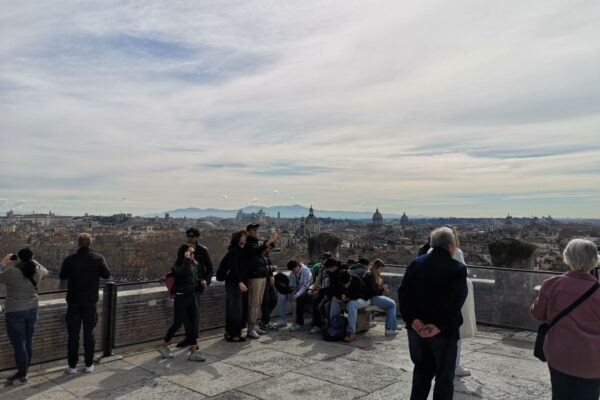Looking for information on the Papal apartments inside Castel Sant’Angelo? Then you have come to the right place!
In this in-depth article, I will tell you about the history in brief of the residential complex located on the high floors of the castle and accompany you through its halls, into the corridors and logues, providing you with a description of the rooms and the works of art they contain.
By the time you have finished reading you will know all about the Papal Residences of Castel Sant’Angelo, how to visit them and which tickets are best to buy to do so;
Are you ready to be captivated by the splendid decorations Renaissance of the Farnesian apartments? Then follow me on this exciting virtual tour!
IMPORTANT! Before you begin with the in-depth reading, read here: I warn you that, given the celebrity of this splendid building, to visit the papal flats of Castel Sant’Angelo you will almost certainly run into a long queue at the ticket office. To enter the castle and skip the queue, I recommend you buy your ticket online. Click below to book your entrance and enter Castel Sant’Angelo in an instant.

Skip-the-line ticket Castel Sant’Angelo Rome: fast access
Buy online. Choose your preferred time. Visit Rome’s Castel Sant’Angelo, the Ponte dell’Angelo, the prisons and much more.
You can cancel free of charge up to the day before the visit.
Papal Fats in The Mole Adriana: History in Brief
Contents
- 1 Papal Fats in The Mole Adriana: History in Brief
- 2 The Pope’s Apartaments Rome: The Rooms
- 2.1 The “Cortile dell’Angelo” (Angel Courtyard)
- 2.2 The Hall of Apollo
- 2.3 The Chapel of Leo X
- 2.4 The Halls of Clement VII
- 2.5 The Courtyard of Leo X
- 2.6 The Bath of Clement VII
- 2.7 The Loggia of Julius II
- 2.8 The Loggia of Paul III
- 2.9 The Sala Paolina
- 2.10 The Hall of Perseus
- 2.11 The Hall of Cupid and Psyche
- 2.12 The Pompeian Corridor
- 2.13 The Library Room
- 2.14 The Hall of the Hadrian
- 2.15 The Hall of Festoons
- 2.16 La Cagliostra
- 3 Farnese Flats Castel Sant’Angelo: How To Visit Them
- 4 Papal Residences Castel Sant’Angelo: Tickets
- 5 Papal residences: Frequently Asked Questions
- 6 Popes’ Apartaments: Conclusions
The first pope to want an apartment inside Castel Sant’Angelo was Nicholas V.
The room, in its initial conception, was to have a function of both accommodation and representation.
Of this early residence, although they retain nothing of the original layout, two rooms survive today: the Halls of Clement VII. In their modern denomination, these rooms are named after the pontiff who ordered their renovation.
Clemente VII was also responsible for the building of the Bagnetto (or Stufetta) that still bears his name.
In the ultimate years of the 15th century,Alexander VI Borgia ordered the construction of a new, sumptuous apartment, with gardens and fountains, entrusting the decoration to Pinturicchio. During his pontificate, receptions and banquettes abounded within the walls of Castel Sant’Angelo.
Unfortunately, today nothing survives of the pontiff’s luxurious residence. It was in fact Pope Urban VIII who ordered its demolition to make way for the new fortifications.
The cultured Paolo III Farnese, towards the mid-16th century, favoured the blossoming of Renaissance taste within the castle walls, entrusting Raffaello di Montelupo with the construction of a fantastic apartment above the old 15th-century residential complex.
The splendid rooms of the Farnesian apartment – the Room of Apollo, the Room of Apollo, the Room of Pauline, the Room of Perseus, the Room of Cupid and Psyche, the Corridor Pompeian, the Library Rooms, the Halls of the Adrianeum and the Festoons, and the Cagliostra – were decorated by a vast équipe of talented painters under Perin del Vaga. Even today, when visiting these rooms, we can admire the impressive work of these artists.
The Pope’s Apartaments Rome: The Rooms
Below I will take you on a virtual tour of the rooms that make up the papal flats inside Castel Sant’Angelo.
The “Cortile dell’Angelo” (Angel Courtyard)
Also known as the Cortile d’Onore, this room took its current form in the first half of the 16th century, between the pontificate of Leo X Medici and that of Paolo III Farnese.
It is initially conceived as a presentational space and, above all, as a huge to the fabulous papal apartments.
The courtyard, with a rectangular plan, is enclosed on one side by the Armerie, and on the other by the old walls of the Mole Adriana, to which the sumptuous halls of the papal residence are attached.
The entrance façade is embellished with a double archway with a central nicchia, commissioned by Paolo III Farnese from Raffaello da Montelupo.
The second fornix frames another ramp of stairs that ascends to the circular walkway.
The side facing the entrance, on the other hand, is enriched by the Edicule of the Chapel of Leo X, created in the early 16th century to a design by Michelangelo Buonarroti.
Both elevations feature a niche housing a manly bust, the work of Guglielmo della Porta in the mid 16th century.
The element that gives the courtyard its name is found in the centre: it is in fact the statue of St Michael the Archangel made in 1544 by Raffaello da Montelupo.
Of the many sculptures placed on the top of Castel Sant’Angelo, apart from the present one, this is the only one that has survived to the present day.
The Archangel Michael, made of marble, is depicted in a long robe in the act of sheathing the sword. The armour is supported by shoulders showing the Farnese Lily.
The size of the head, which is disproportionate to the rest of the body, is justified by the original location, which envisaged a bottom-up view.
The wings, made of originally gold-plated metal, are perforated to decrease wind friction force.
Once replaced, after more than two hundred years spent on the top of the castle, the sculpture was transported to a corner of the Paul III staircase and then, at a later date, to its current location, namely in this court that, in 1910, took its name.
Below, behind the statue of St Michael the Archangel, a large wolf-mouth window provides light to the imperial tomb below, while above it rises the complex of the papal apartments.
For more information, read my article on the Angel Courtyard.
The Hall of Apollo
The main room of the first floor of the papal apartments, this large vaulted hall was built under the pontificate of Niccolò V.
The adjacent rooms of the Chapel, the Halls of Clement VII and the Bathroom of Clement VII were added from the 16th century.
The decoration was commissioned by Paolo III Farnese to Perin del Vaga and his collaborators, who were already working on the upper floors.
The walls and the vault display a rich grotesque decoration on a white background.

On the ceiling are ten panels showing some stories of the god Apollo and giving the room its name.
In the lunettes, on the other hand, the Liberal Arts are represented. All these elements recall the myth of the god Apollo and his role as protector of the humanities.
As in the decorations of other rooms ordered by Paul III, here too elements of pagan mythology alternate with papal heraldry, testifying to the love of the pontiff for the Neoplatonic culture.
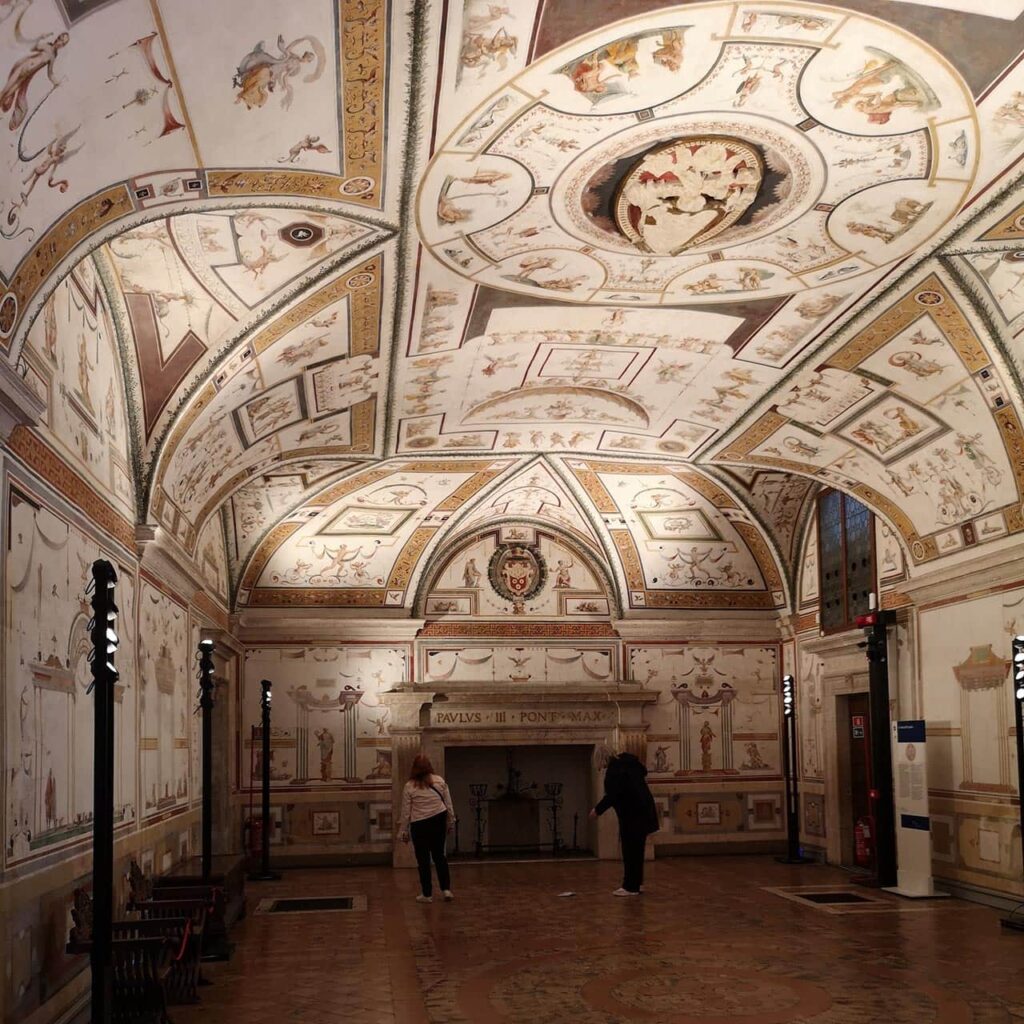
The room features the Lily of Justice and the Festina Lente, both characteristic of the Farnese family.
The name of the pontiff can be found on the marble fireplace, made by Raffaello da Montelupo, and in the frets of the doors.
The Chapel of Leo X
The Cappella di Leone X is the only surviving chapel of the many documented inside Castel Sant’Angelo.
As its name suggests, it was built by Pope Leo X Medici and consecrated to Saints Cosmas and Damian, the patron saints of his house.
It is a small environment and, nowadays, almost entirely dirty.
The Paptifical coat of arms, with the characteristic Medicean balls, can still be seen in the centre of the moon vault.

We also find traces of the patron on the floor: the brick tiles that make up the central carpet bear the small figure of a lion in the centre, while those on the border show the Medicean coat of arms.
The altar was made in the XX century as a furnishing element for the chapel. Above it is a bass relief of the Madonna Enthroned with Child, by Raffaello da Montelupo, originally located in another part of the castle.
The chapel also features a small room that served as a sagristy.
A utility staircase leads from this room to the diameter staircase, while another staircase connects the entrance hall to the upper apartments.
The Halls of Clement VII
These two rooms, named after the pontefice who ordered their decoration, are the chambers of service for private use reserved by the popes.
The name of Clemente VII Medici can still be found in the inscription in the centre of the coffered ceilings, as well as in the cartigli painted in the fregio of the first room by Michele di Bartolomeo da Lucca and Matteo Crassetti da Terranova.
The frey in the second room was replaced by Innocent X with a painting bearing the heraldic attributes of the family.
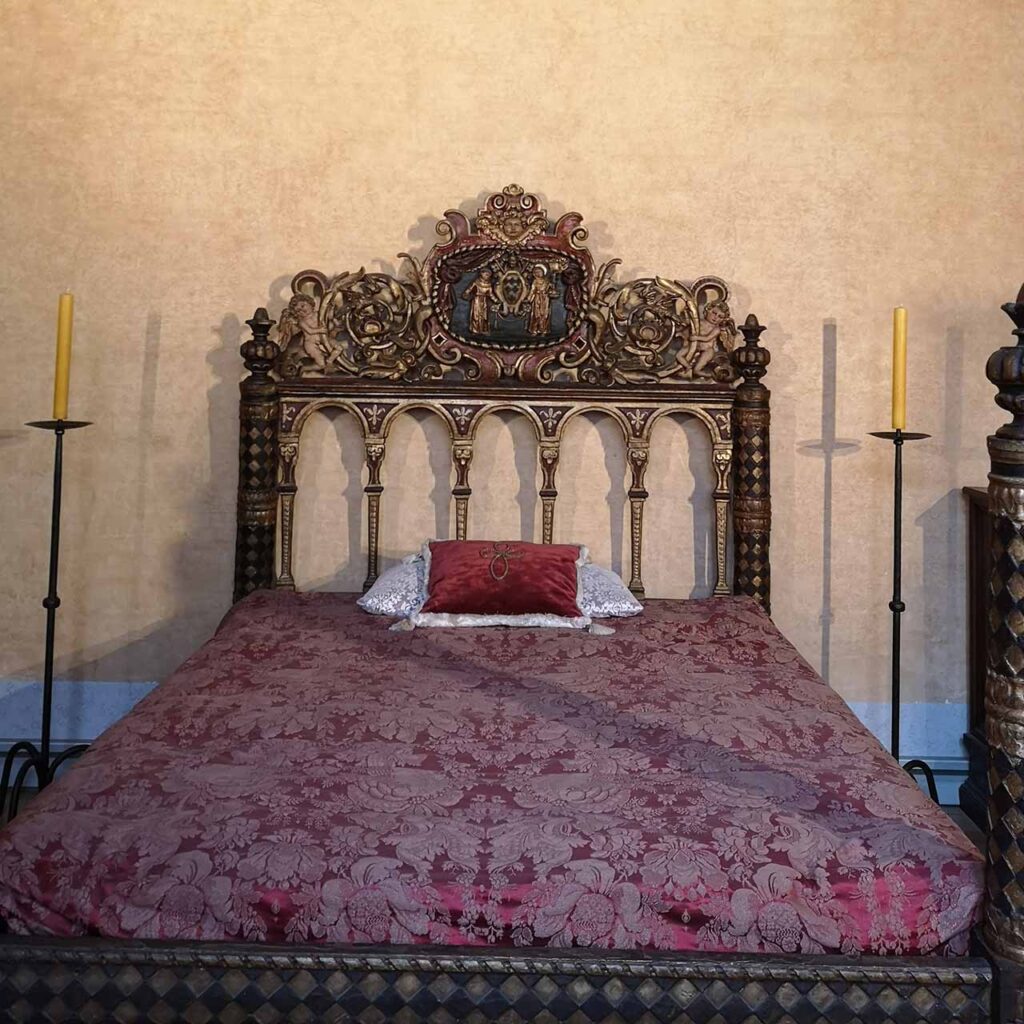
The rooms, with large windows, were originally frescoed with the symbols of the house of Medici. They were provided with gradings and seats at the behest of Pope Julius II Rovere.
The cotto floors, which have been restored several times, date back to the pontificate of Paolo III Farnese.
From the first chamber, a door leads to the Courtyard of Leo X. From the second chamber, a door leads to the bathroom of Clement VII, also known as the Stufetta.

The Courtyard of Leo X
Also known as ‘del forno‘, because it was from here that the fires that heated the Stufetta room were lit, this small courtyard was built by Leon X around 1514.
It is likely that, at one time, the small room housed a Italian garden, similar to the one that extended into the Courtile of Alexander VI.
Opening onto the courtyard are the two windows of the Salons of Clement VII and two doors, on which can be seen the inscription of the names of the pontiffs Giulius II and Leo X.
The Bath of Clement VII
The construction of this room dates back to the pontificate of Julius II della Rovere, while the decoration by Giovanni da Udine, a pupil of Raffaello, was commissioned by Clemente VII Medici.
The room, fitted with a tub and used as a bathroom, was equipped with a heating system connected to a oven accessed from the Courtyard of Leo X.
The heraldic symbols, as well as the mythological scenes linked to the element of water, stand out against a surface covered with a rich grotesque decoration, dense with sea animals and sphinxes.
The cameos of the pope and the castellan Guido de’ Medici are found in the centre of the vault. All around, in imitation of antique cameos, ovals with putti abound.
Venus and Love are the protagonists of four mythological scenes with an aquatic theme, and Greek mythology also returns in the seven thrones of the main divinities of Olympus, purposely left empty to create the illusion that the occupants were taking a bath with the pontiff.
The two spouts of the basin, bearing the symbols of a basin and a brazier, testify to the fact that the pope had access to hot and cold water.
The Loggia of Julius II
The Loggia of Julius II is the vaulted room of access to the Sala Paolina. Overlooking the The Tiber, the loggia was built at the behest of Julius II and under the supervision of Castellan Marco Vigerio by the architects Giuliano da Sangallo and Donato di Angelo di Pascuccio, known as Bramante.
The elevation consists of a marble parapet and four columns, two of which are set against the jambs.
On the architecture, the inscription ‘IVL II PONT MAX ANNO II’ under the stem of Oak is visible from the outside.
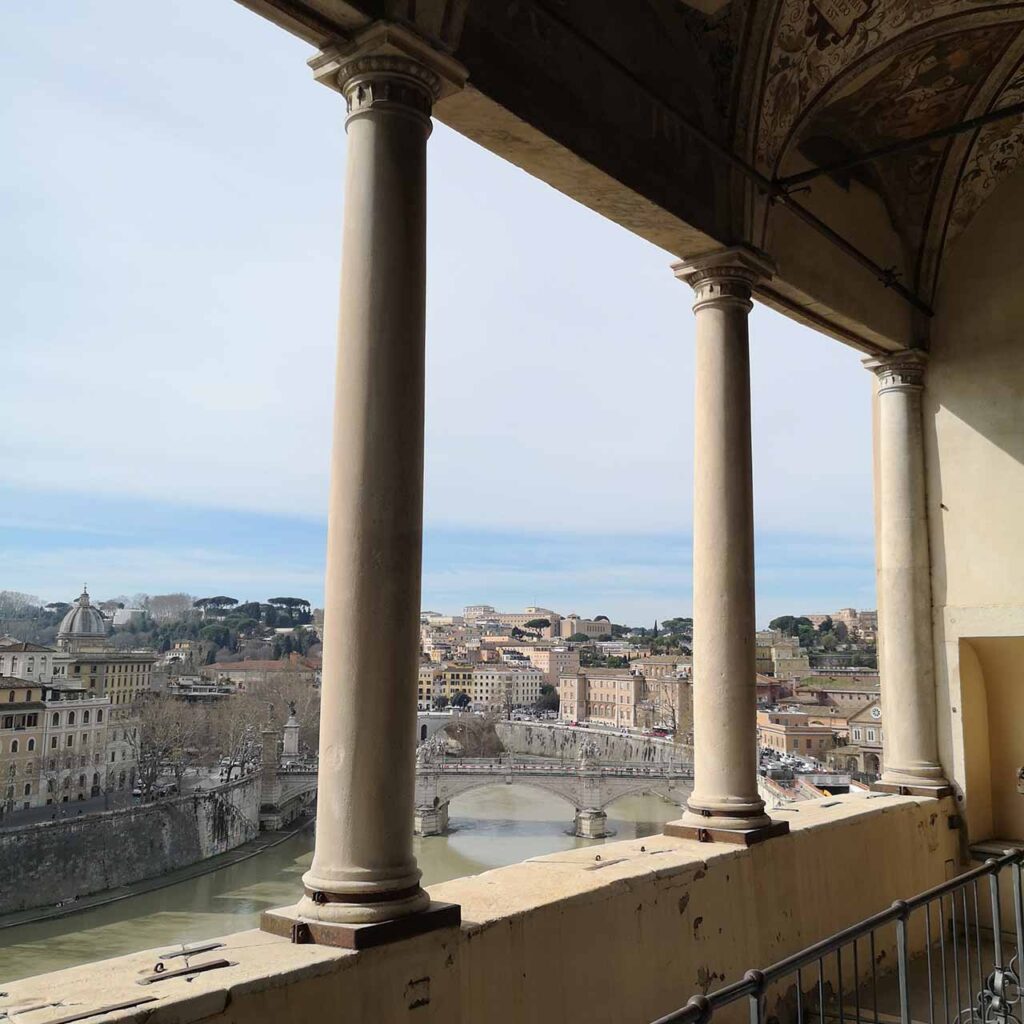
The capitals of the columns are decorated with small acorns and leaves, the heraldic motif of the pontiff’s family.
The pinnacles of the vault are decorated with vegetable swirls that stand out against a light field, while on the sails we find, among the decorative motifs, acanthus spirals, surmounted by putti and caryatids.
Remnants of the same motifs also survive on the lunettes of the walls. Also painted on the vault are four cartouches bearing four Latin mottos alluding to the function of this lodge of blessings.
Recently, the paintings have been attributed to Michele del Becca da Imola and Pier Matteo d’Amelia.
The Loggia of Paul III
Completed in 1543, this monumental room was the entrance to the flats of Pope Paul III.
The Loggia is formed by five arches supported by pilasters, externally decorated with a relief frieze bearing lilies, the motif of the Farnese family.
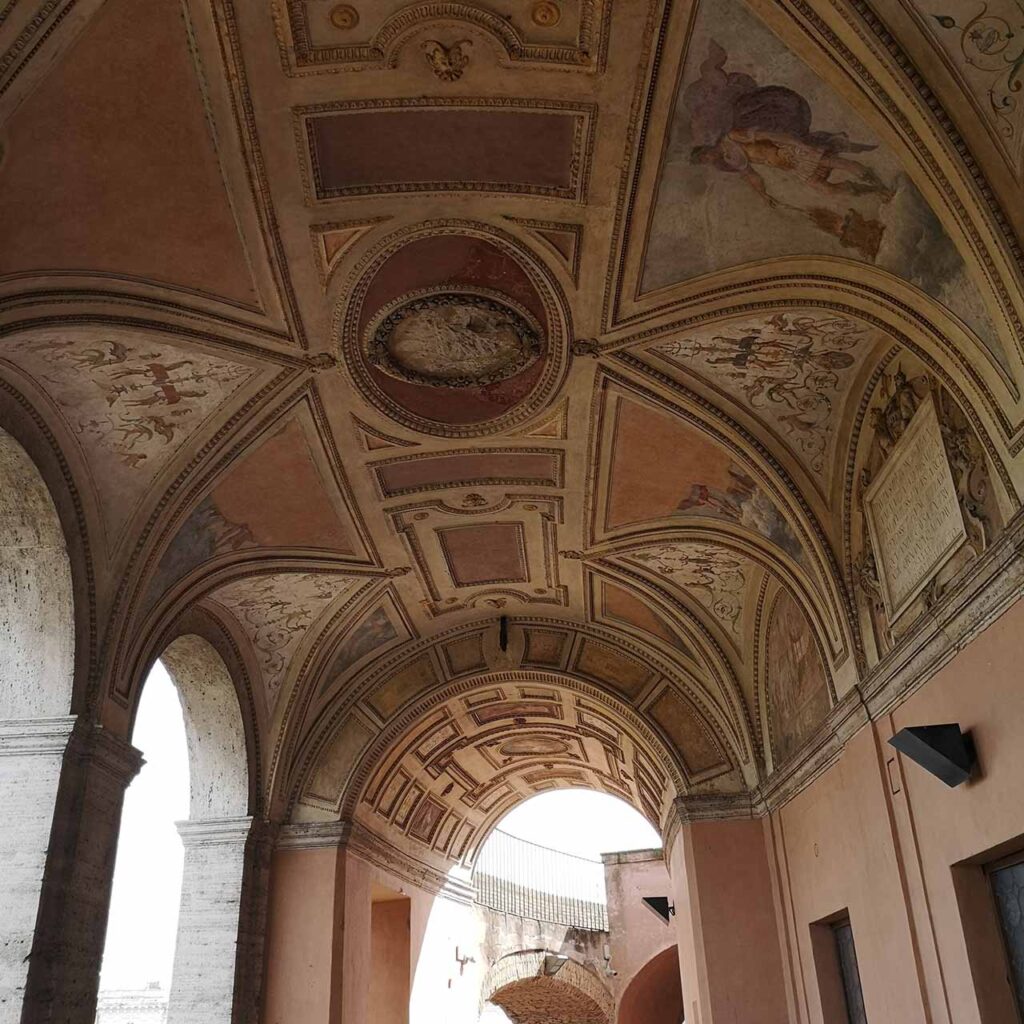
Inside, the large barrel vault is decorated with frescoes by Girolamo Siciolante da Sermoneta.
The six sails are decorated with grotesques on a light background, while the pinnacles depict scenes from the life of Emperor Hadrian.
The two lunettes on the inner wall contain depictions of the Mole Adriana and the Villa Adriana.
At the centre of the vault, framed in stucco, we now find only a remnant of the stem of the pontiff.
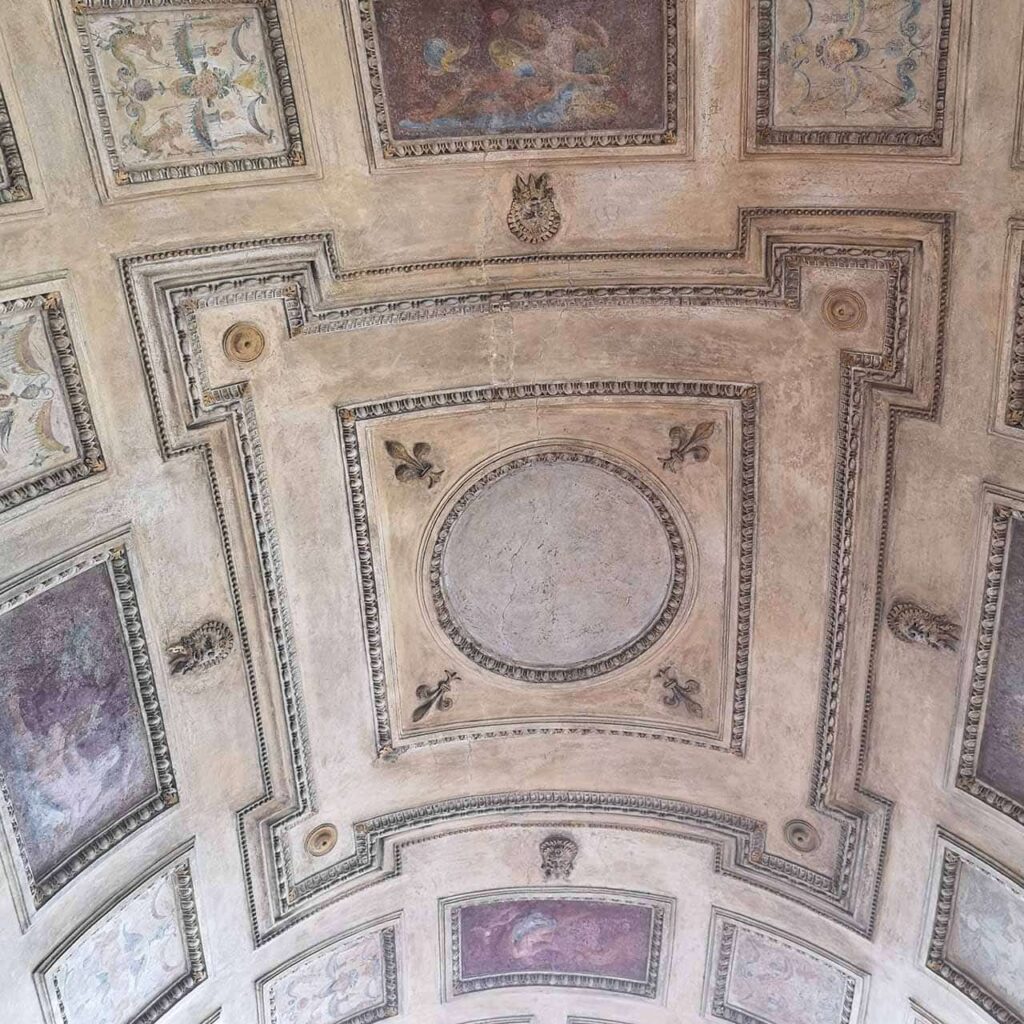
The Sala Paolina

The Sala Paolina was the personal salon of Pope Paul III Farnese, whose name it still bears today. Emperors, kings, ambassadors and consuls from all over the world were hosted here.
The decorative ensemble of the room represents one of the greatest artistic episodes of the Roman Century. The work was entrusted to Perin del Vaga, who carried it out between 1545 and 1547 with the help of a number of illustrious collaborators, including Pellegrino Tibaldi, Luzio Luzi, Domenico Rietti and Giacomo Bertucci.
The frescoes depict scenes from the lives of the pope’s ‘namesakes’, Alexander the Great and St. Paul, who would have been linked to the pontiff.
The vault is very rich: at the centre we find the stemma of Paul III and all around a complex of grotesque panels, stucchi, papal assemblages and cartiglia bearing inscriptions in Greek, bearing witness to the humanistic culture of the pontiff.
Six fresco panels, by Marco Pino, depict important episodes from the life of Alexander the Great.
Beneath the cornice, along all four sides of the rectangular room, runs a written Latin inscription celebrating the restoration of the old Mole Adriana and construction of the Papal Residence.
On the walls we find a feint architecture, composed of Ionic columns and nicnicoloured figures housing the allegorical figures of the Cardinal Virtues of Strength, Justice, Temporance and Prudence.
These are alternated with panels depicting other Stories of Alexander the Great, while above the ports are illustrations of six Stories of St. Paul.
At the centre of the short walls, majestically frescoed are the portraits of the Emperor Hadrian and the Arcangel Michael sheathing his sword, homage respectively to the founder and the Christian protector of the place by Girolamo Siciolante da Sermoneta and Pellegrino Tibaldi.
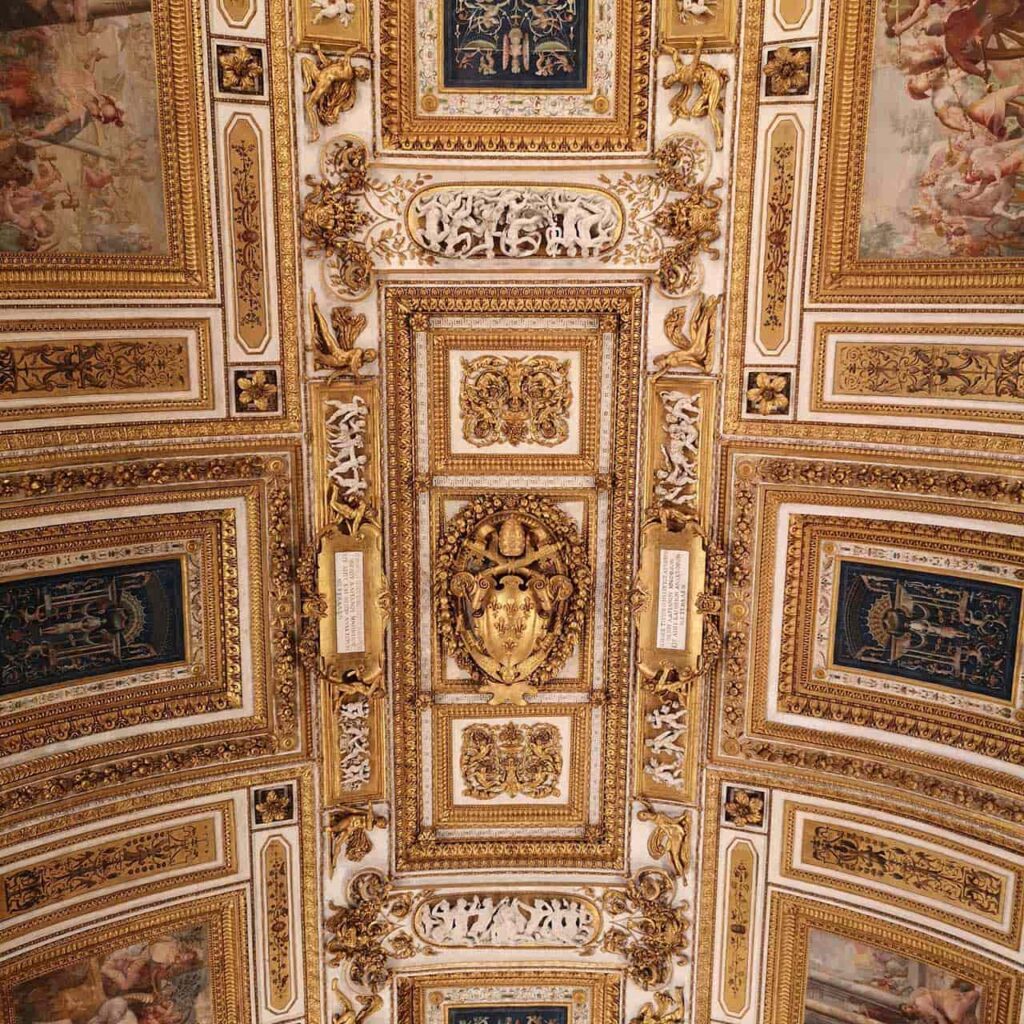
The floor that we see today is more recent; the original terracotta floor was replaced in the 1820s by Innocentence XIII, whose papal coat of arms still stands in the centre.
The generally solemn tones of the room’s decorative apparatus are mitigated by two trompe-l’oeil doors from which a courtier (according to some, the architect Antonio da Sangallo il Giovane) and some servants descend a staircase with a basket of fruit.
Beneath the portrait of Saint Michael the Archangel, two baboons pop up: according to some in memory of a homage from some foreign ambassadors to the pontiff, according to others to suggest the name of the author Giacomo Bertucci, as a signature.
For more information, read my article on the Sala Paolina and adjacent rooms.

Skip-the-line ticket Castel Sant’Angelo Rome: fast access
Buy online. Choose your preferred time. Visit Rome’s Castel Sant’Angelo, the Ponte dell’Angelo, the prisons and much more.
You can cancel free of charge up to the day before the visit.
The Hall of Perseus

The Sala di Perseo was the study of the pontiff Paul III. The ceiling and the upper part of the walls were decorated by Perin del Vaga and his team.
The ceiling is coffered, with grotesque motifs and heraldic symbols; in the centre stands, in relief, the figure of St. Michael the Archangel.
In the Fregium it is Perseus who takes centre stage. With six large panes, the fresco depicts many of the events of the Greek hero taken from Ovid’s “Metamorphoses”.
The scenes are set in a faux architecture of framed frames and counterframes, with fruit festoons, masks and flowers. Alternating with panels depicting Perseus are monumental maidens with unicorns, emblems of the Farnese.
The mythological cycle should be “read” from the left of the entrance, where we find the “Hero’s Farewell to the Mother Danae” and “Perseus Receiving the Gifts of Mercury and Minerva“, and then proceeding clockwise to the last episodes on the door to the Sala Paolina: “The Return of Perseus“, “The Origin of Coral” and the “Nuptial Banquet of Perseus and Andromeda“.

Today, in the room we can also admire part of the rich Castel Sant’Angelo collection of works, including the Christ Blessing and the St. Onofrio by Carlo Crivelli, the St. Jerome by Lorenzo Lotto and the Lamentation over the Dead Christ by an unknown author.
The room communicates with the underlying Bathroom of Clement VII and the pontiff’s adjoining bedroom, the Room of Cupid and Psyche.
For more information, read my article on the Sala Paolina and adjacent rooms.
The Hall of Cupid and Psyche

The Sala di Amore e Psiche was the bedroom of Paolo III Farnese. The decoration of the ceiling and walls was entrusted to Perin del Vaga.
The coffered ceiling, with grotesques on a gold background and lilies alternating with targets with the name of the pontiff, has at its centre, in relief, the great Farnesian coat of arms.
On the frage, framed by false corbels and curtains, we find nine panels depicting as many episodes from the fable of Cupid and Psyche as narrated in The Golden Ass by Apuleius, to which is added a tenth scene, painted over the window.
The panels alternate between big winged victories and panels with grotesques on a gold background.
The scandalous presence of such a sensual story must be explained by reading the fable through the eyes of the pontiff, who, with his strictly neo-Platonic culture, gave it a strongly allegorical reading in Christian key.
However, the sensuality of the tale remains explosive in scenes such as ‘Psiche discovers Love and Love flees‘, the most famous of the entire cycle.
In addition to the splendid frescoes, the room currently houses important works such as Christ Carrying the Cross by Paris Bordon and The Bath by Giovanni Luteri, known as Dosso Dossi.
For more information, read my article on the Sala Paolina and adjacent rooms.
The Pompeian Corridor
Created in the XVI century from a wooden gallery, the Pompeian Corridor is the narrow passage connecting the Paoline Room to the Library Room.
It earned this name thanks to the rich grotesque decoration that covers both its walls and the barrel vault.
The frescoes were executed between 1545 and 1546 by Luzio Luzi and Perin del Vaga, assisted by high-calibre artists such as the Flemish Cornelis Loots, to whom we owe the small Nordic landscapes on the lower part of the walls, and Cristofano Gherardi da Borgo San Sepolcro, author of some other figures in the grotesques.
The Library Room
The salon is the main room of the north wing of the apartments of Paul III Farnese. It only gained its name in the Nineteenth Century, probably in connection with its proximity to the Treasure Room, home not only to the Heritage, but also to the Papal Secret Archive.
The decorative apparatus was entrusted by the pontiff to Luzio Luzi. On the eastern wall we can see a large fireplace and, above it, the imposing allegories of the Church and Rome with the Papal crest in the centre.

The wide vault, decorated with stuccoes and grotesques, is divided into five concentric registers and framed by two continuous friezes.
The former is composed of twenty-eight relief lunettes alternating pagan depictions with Farnesian assemblages, while the latter, located a little higher up, is painted with sea creatures and interrupted, at the centre of each wall, by stucco medallions.
In the vault, alternating with grottes on a white background, are ten Stories of Ancient Rome.
On the short sides are portraits of St Michael the Archangel and the Emperor Hadrian. At the centre, flanked by the embodiments of the Virgin with a Unicorn and the Lily of Justice, we find the Farnese coat of arms.
The Hall of the Hadrian
Through the Library Room one enters the small room of the Hadrian Room, a room that owes its name to the mural paintings that emerged during the restoration of Castel Sant’Angelo in 1902.
Together with the adjacent Sala dei Festoni, it was one of the first rooms built by order of Paul III.
On the top of the walls we find a frey made by Luzio Luzi and his team between 1544 and 1545.
The frieze depicts scenes from mythology and figures of satyrs. At the centre of each wall, framed by faux architecture, we find views of ancient Roman monuments such as the Naumachia of Domitian, the Meta Romuli, the Cirque of Caligula and Nero and the Mausoleum of Hadrian itself.
Other eight panels, two on each wall, depict scenes from the Dionysian world, populated by anthropic gods, satyrs and maenads.
The Hall of Festoons
This sala, which only gained its current name in the Nineteenth Century, is also characterised by a rich decorative frieze placed on the top of its walls.
The currents of nereids and dancing tritons, alternating with male, female and unicorn figures, suggest a continuous, undulatory movement: hence the name ‘of the Festoons‘.
The wonderful paintings are once again the work of Luzio Luzi and his team of artists.
Unfortunately, the original ceilings that completed the decoration of the room similar to what can be seen in the Hall of Perseus and the Hall of Cupid and Psyche have not survived to this day.
The hall is connected by stairs to the utility rooms of the Court of Alexander VI and the Cagliostra.
La Cagliostra
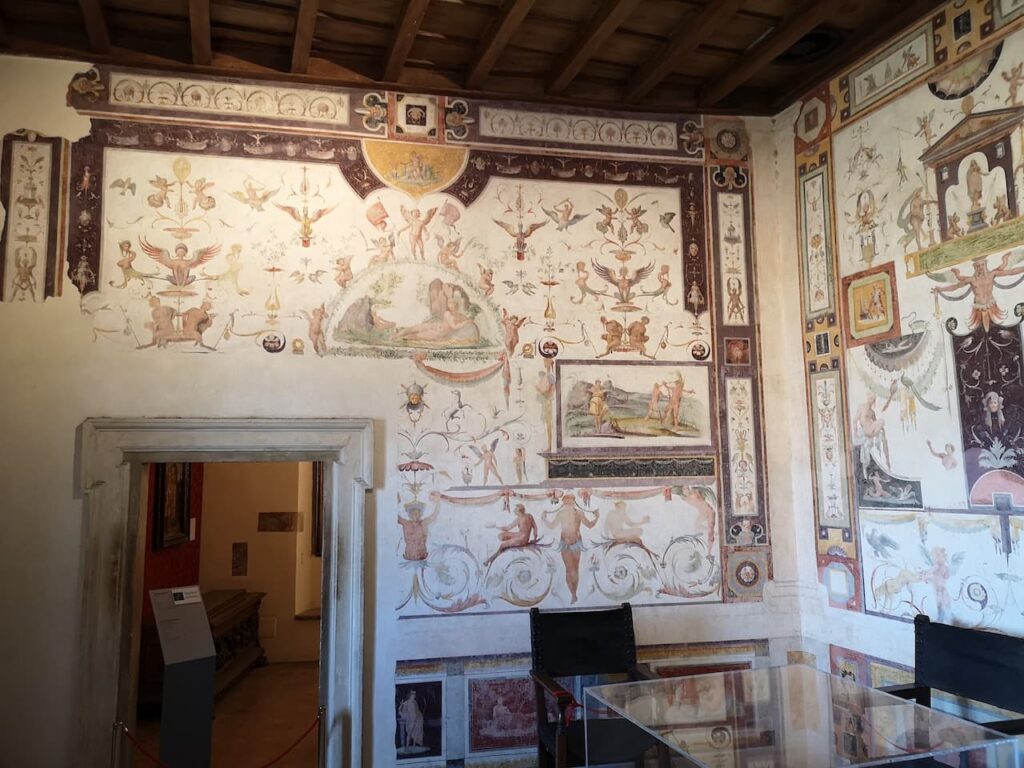
This room was built in 1543 together with the Loggia of Paul III below.
Initially, its arches opened towards the Burg of Prati, but in the XVIII century they were murdered to convert the room into a prison for prisoners of note.
For it was here, in 1789, that the adventurer, esotericist and alchemist Italian Giuseppe Balsamo Conte di Cagliostro was incarcerated by the Inquisition for about a year.
The small apartment consists of three rooms: one large, central room and two side rooms.
From the heraldic emblems of Paul III, depicted at the centre of the faces, the two dressing rooms are named the Dolphin and Salamander Cabinet and the Stork Cabinet.
The grotesque decoration of the interior walls, in typical Renaissance style, depicts a celebral landscape inhabited by celestial figures and bears the signatures of the illustrious painters Luzio Luzi and Perin del Vaga.
Farnese Flats Castel Sant’Angelo: How To Visit Them
To visit the Papal apartments you only need to buy a entrance ticket to the National Museum of Castel Sant’Angelo.
The entrance ticket alone, in fact, guarantees access to this vast area that, except for specific maintenance work, is normally open to visitors.
To reach the courtyard, the first room in the residential complex, one must ascend via the helical ramp that leads from the outside courtyard to the Sala delle Urne, and then proceed via the diameter path that runs through it.
Persons with disabilities, or their escorts, may contact the museum staff to request use of the private lift.
The visiting hours are naturally linked to the opening hours of the National Museum of Castel Sant’Angelo, i.e. Tuesday to Sunday, from 9.00 to 19.30 with last admission at 18.00.
What are you waiting for? Are you ready to visit the Papal Residences of Castel Sant’Angelo? Read on for the best tickets to visit.
Papal Residences Castel Sant’Angelo: Tickets
Unlike other areas of Castel Sant’Angelo, the rooms of the Papal Apartments can also be visited to a large extent without the accompaniment of an official guide.
However, it is possible – and in many ways advisable – to pre-book a audioguide or a guided tour of the castle.
Below I leave you our selection of the best tickets you can buy online. I’m sure you’ll find one that suits you!

Skip-the-line ticket Castel Sant’Angelo Rome: fast access
Buy online. Choose your preferred time. Visit Rome’s Castel Sant’Angelo, the Ponte dell’Angelo, the prisons and much more.
You can cancel free of charge up to the day before the visit.
Papal residences: Frequently Asked Questions
Castel Sant’Angelo is state-owned property of the Italian State, which currently manages it through the Direzione Musei statali di Roma.
Inside the Castel Sant’Angelo, you can still admire the Tomb of Hadrian, the circular staircase, the Papal lodgings, the frescoes, the campus of executions, the Grande Loggia, the bastions, the well-preserved fortress rooms, and much more.
The entrance tickets to the National Museum of Castel Sant’Angelo have varying prices depending on the desired ancillary services.
The price of the standard ticket with reserved entrance starts at €20, with the addition of the audioguide the basic price rises to €32, while the cost of the guided tour starts at €37.
You can also buy a combined ticket with other attractions in Rome or the Vatican.
If you are staying in Rome for a few days and don’t want to miss anything, you may find it convenient to purchase the Rome Pass (from €55) or the Rome Tourist Card (from €95).
The Tosca, heroine of the historical drama by Victorien Sardou and the opera based on Puccini, in the last act throws herself off the Castel Sant’Angelo where her lover, the painter Mario Cavaradossi, has just been deceived.
Popes’ Apartaments: Conclusions
And here we come to the end of this in-depth study on the complex of the papal flats in Castel Sant’Angelo.
In this post I have told you about the history in brief of their construction, from the original design by Niccolò V to their enormous expansion under Paolo III Farnese.
I have accompanied you to all the rooms that can still be visited today, providing you with an accurate description of the rooms and works of art that you can admire during your visit.
I also gave you some tips on how to visit them and recommended the best tickets to buy for your future visit.
In conclusion, I wanted to answer the most frequently asked questions, in the hope that this additional information will be useful to you.
If you need more information, please leave a comment below; if you would like to visit the papal flats inside Castel Sant’Angelo, click here and buy your ticket and skip the queue at the ticket office.
